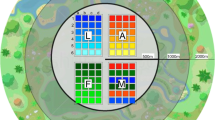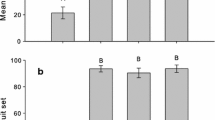Abstract
Responses of flower-visiting animals to floral density can alter interactions between plants, influencing a variety of biological processes, including plant population dynamics and the evolution of flowering phenology. Many studies have found effects of floral or plant density on pollinator visitation rates at patch scales, but little is known about responses of flower visitors to floral densities at larger scales. Here, I present data from an observational field study in which I measured the effects of floral density on visitation to the annual composite Holocarpha virgata at both patch (4 m2) and site (12.6 ha) spatial scales. The species composition of flower visitors changed with floral density, and did so in different ways at the two scales. At the site scale, average floral density within patches of H. virgata or within patches of all summer-flowering species combined had a significant positive effect on per-flowerhead visitation by the long-horned bee Melissodes lupina and no significant effects on visitation by any other taxa. At the patch scale, per-flowerhead visitation by honeybees significantly increased whereas visitation by M. lupina often decreased with increasing floral density. For both species, responses to patch-scale floral density were strongest when site-scale floral density was high. The scale-dependence of flower visitor responses to floral density and the interactions between site- and patch-scale effects of floral density observed in this study underscore the importance of improving our understanding of pollinators’ responses to floral density at population scales.


Similar content being viewed by others
References
Anderson MJ, Ter Braak CJF (2003) Permutation tests for multi-factorial analysis of variance. J Stat Comput Simul 73:85–113
Aschero V, Vazquez DP (2009) Habitat protection, cattle grazing and density-dependent reproduction in a desert tree. Austral Ecol 34:901–907
Bernhardt CE, Mitchell RJ, Michaels HJ (2008) Effects of population size and density on pollinator visitation, pollinator behavior, and pollen tube abundance in Lupinus perennis. Int J Plant Sci 169:944–953
Beyer HL (2004) Hawth’s analysis tools for ArcGIS. Available at http://www.spatialecology.com/htools
Brys R, Jacquemyn H, Hermy M (2008) Pollination efficiency and reproductive patterns in relation to local plant density, population size, and floral display in the rewarding Listera ovata (Orchidaceae). Bot J Linn Soc 157:713–721
Cheptou PO, Avendano LG (2006) Pollination processes and the Allee effect in highly fragmented populations: consequences for the mating system in urban environments. New Phytol 172:774–783
Chittka L, Schurkens S (2001) Successful invasion of a floral market: an exotic Asian plant has moved in on Europe’s river-banks by bribing pollinators. Nature 411:653
Conner JK, Neumeier R (1995) Effects of black mustard population size on the taxonomic composition of pollinators. Oecologia 104:218–224
Courchamp F, Berec L, Gascoigne J (2008) Allee effects in ecology and conservation. Oxford University Press, Oxford
Dauber J et al (2010) Effects of patch size and density on flower visitation and seed set of wild plants: a pan-European approach. J Ecol 98:188–196
Devaux C, Lande R (2010) Selection on variance in flowering time within and among individuals. Evolution 64:1311–1320
Dyer FC (2002) The biology of the dance language. Annu Rev Entomol 47:917–949
Ehlers BK, Olesen JM, Agren J (2002) Floral morphology and reproductive success in the orchid Epipactis helleborine: regional and local across-habitat variation. Plant Syst Evol 236:19–32
Essenberg CJ (2012) Explaining variation in the effect of floral density on pollinator visitation. Am Nat. doi:10.5061/dryad.mf172sf0
Feinsinger P, Tiebout HM, Young BE (1991) Do tropical bird-pollinated plants exhibit density-dependent interactions? Field experiments. Ecology 72:1953–1963
Feldman TS (2006) Pollinator aggregative and functional responses to flower density: does pollinator response to patches of plants accelerate at low-densities? Oikos 115:128–140
Feldman TS (2008) The plot thickens: does low density affect visitation and reproductive success in a perennial herb, and are these effects altered in the presence of a co-flowering species? Oecologia 156:807–817
Feldman TS, Morris WF, Wilson WG (2004) When can two plant species facilitate each other’s pollination? Oikos 105:197–207
Field DL, Ayre DJ, Whelan RJ (2005) The effect of local plant density on pollinator behavior and the breeding system of Persoonia bargoensis (Proteaceae). Int J Plant Sci 166:969–977
Ghazoul J (2005) Pollen and seed dispersal among dispersed plants. Biol Rev 80:413–443
Ghazoul J (2006) Floral diversity and the facilitation of pollination. J Ecol 94:295–304
Ginsberg HS (1983) Foraging ecology of bees in an old field. Ecology 64:165–175
Grindeland JM, Sletvold N, Ims RA (2005) Effects of floral display size and plant density on pollinator visitation rate in a natural population of Digitalis purpurea. Funct Ecol 19:383–390
Hegland SJ, Boeke L (2006) Relationships between the density and diversity of floral resources and flower visitor activity in a temperate grassland community. Ecol Entomol 31:532–538
Hickman JC (ed) (1993) The Jepson manual: higher plants of California. University of California Press, Los Angeles
Ikemoto M, Ohgushi T, Craig TP (2011) Space-dependent effects of floral abundance on flower visitors. J Plant Interact 6:177–178
Ivey CT, Martinez P, Wyatt R (2003) Variation in pollinator effectiveness in swamp milkweed, Asclepias incarnata (Apocynaceae). Am J Bot 90:214–225
Jha S, Vandermeer JH (2009) Contrasting bee foraging in response to resource scale and local habitat management. Oikos 118:1174–1180
Johnson LK, Hubbell SP (1975) Contrasting foraging strategies and coexistence of two bee species on a single resource. Ecology 56:1398–1406
Kandori I, Hirao T, Matsunaga S, Kurosaki T (2009) An invasive dandelion unilaterally reduces the reproduction of a native congener through competition for pollination. Oecologia 159:559–569
Kunin WE (1997a) Population biology and rarity: on the complexity of density-dependence in insect-plant interactions. In: Kunin WE, Gaston KJ (eds) The biology of rarity: causes and consequences of rare-common differences. Chapman and Hall, London, pp 150–173
Kunin WE (1997b) Population size and density effects in pollination: pollinator foraging and plant reproductive success in experimental arrays of Brassica kaber. J Ecol 85:225–234
Kwak MM (1987) Pollination and pollen flow disturbed by honeybees in bumblebee-pollinated Rhinanthus populations? In: van Andel J, Bakker JP, Snaydon RW (eds) Disturbance in grasslands: causes, effects and processes. Junk, Boston, pp 273–283
Kyhos DW, Carr GD, Baldwin BG (1990) Biodiversity and cytogenetics of the tarweeds (Asteraceae: Heliantheae-Madiinae). Ann Mo Bot Gard 77:84–95
Larsson M (2005) Higher pollinator effectiveness by specialist than generalist flower-visitors of unspecialized Knautia arvensis (Dipsacaceae). Oecologia 146:394–403
Lundberg S, Ingvarsson PK (1998) Population dynamics of resource limited plants and their pollinators. Theor Popul Biol 54:44–49
Morgan RA, Brown JS, Thorson JM (1997) The effect of spatial scale on the functional response of fox squirrels. Ecology 78:1087–1097
Mustajarvi K, Siikamaki P, Rytkonen S, Lammi A (2001) Consequences of plant population size and density for plant-pollinator interactions and plant performance. J Ecol 89:80–87
Pinheiro JC, Bates DM (2000) Mixed-effects models in S and S-PLUS. Springer, New York
Pinheiro J, Bates D, DebRoy S, Sarkar D, the R Core team (2009) nlme: linear and nonlinear mixed effects models. R package version 3.1-89
R Development Core Team (2010) R: a language and environment for statistical computing. R Foundation for Statistical Computing, Vienna
Rader R, Howlett BG, Cunningham SA, Westcott DA, Edwards W (2012) Spatial and temporal variation in pollinator effectiveness: do unmanaged insects provide consistent pollination services to mass flowering crops? J Appl Ecol 49:126–134
Roff DA (2006) Introduction to computer-intensive methods of data analysis in biology. Cambridge University Press, New York
Schaffer WM, Jensen DB, Hobbs DE, Gurevitch J, Todd JR, Schaffer MV (1979) Competition, foraging energetics, and the cost of sociality in three species of bees. Ecology 60:976–987
Sih A, Baltus MS (1987) Patch size, pollinator behavior, and pollinator limitation in catnip. Ecology 68:1679–1690
Sober V, Teder T, Moora M (2009) Contrasting effects of plant population size on florivory and pollination. Basic Appl Ecol 10:737–744
Sowig P (1989) Effects of flowering plant’s patch size on species composition of pollinator communities, foraging strategies, and resource partitioning in bumblebees (Hymenoptera, Apidae). Oecologia 78:550–558
Stephens PA, Sutherland WJ (1999) Consequences of the Allee effect for behaviour, ecology and conservation. Trends Ecol Evol 14:401–405
Tanner DA, Visscher PK (2008) Do honey bees average directions in the waggle dance to determine a flight direction? Behav Ecol Sociobiol 62:1891–1898
Veddeler D, Klein AM, Tscharntke T (2006) Contrasting responses of bee communities to coffee flowering at different spatial scales. Oikos 112:594–601
Wagenius S, Lyon SP (2010) Reproduction of Echinacea angustifolia in fragmented prairie is pollen-limited but not pollinator-limited. Ecology 91:733–742
Wilson P, Thomson JD (1991) Heterogeneity among floral visitors leads to discordance between removal and deposition of pollen. Ecology 72:1503–1507
Zorn-Arnold B, Howe HF (2007) Density and seed set in a self-compatible forb, Penstemon digitalis (Plantaginaceae), with multiple pollinators. Am J Bot 94:1594–1602
Acknowledgments
I thank Matthew Poonamallee, Emily Bergmann, and Susan Bury for assistance in collecting field data. I am grateful to John Rotenberry, Paul Aigner, Doug Yanega, the University of California-Riverside Biology Department Lab Prep staff, Derek Roff, Dmitry Maslov, Barbara Walter, Morris and Gina Maduro, Ed Platzer, Rhett Woerly, and the University of Califorina-Riverside Entomology Research Museum for providing advice, equipment, and/or assistance with logistical challenges. I thank John Rotenberry, Kurt Anderson, Rick Redak, and two anonymous reviewers for comments on the manuscript. This work was performed at the University of California Natural Reserve System’s Donald and Sylvia McLaughlin Reserve. Funding was provided by the University of California-Riverside, a National Science Foundation Graduate Research Fellowship, and a Mildred E. Mathias Graduate Student Research Grant from the University of California Natural Reserve System. All methods carried out in this study comply with the current laws of the United States of America.
Author information
Authors and Affiliations
Corresponding author
Additional information
Communicated by Florian Schiestl.
Electronic supplementary material
Below is the link to the electronic supplementary material.
Rights and permissions
About this article
Cite this article
Essenberg, C.J. Scale-dependent shifts in the species composition of flower visitors with changing floral density. Oecologia 171, 187–196 (2013). https://doi.org/10.1007/s00442-012-2391-z
Received:
Accepted:
Published:
Issue Date:
DOI: https://doi.org/10.1007/s00442-012-2391-z




